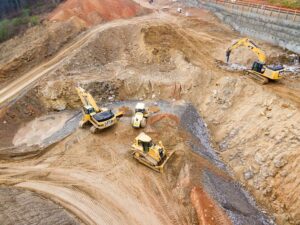Comprehensive Guide to Regulations for Drainage Systems in Kentucky
Excavation and civil works projects in Kentucky demand strict adherence to drainage regulations to prevent sediment pollution, flooding, and costly compliance failures. This guide delivers actionable insights into state and local stormwater, sewer, land disturbance, and floodplain requirements, demonstrating how proper planning, permits, and best management practices align with Kentucky’s regulatory framework. You will learn about key agencies, permit processes like KPDES General Permit (KYR10), on-site sewage rules under 902 KAR 10:085, municipal MS4 obligations, erosion control standards, and the legal implications of non-compliance. Along the way, discover how Earth Works, LLC’s excavation and civil works expertise ensures your project remains fully compliant and on schedule.
What Are the Key Kentucky Stormwater Regulations for Construction and Development?
Kentucky’s stormwater regulations govern runoff from active construction sites and post-construction developments to protect water quality under the Clean Water Act framework. By requiring permits for sites disturbing one acre or more, these rules enforce erosion and sediment control measures that maintain compliance with the Kentucky Pollutant Discharge Elimination System (KPDES). Effective management minimizes pollutant loads, reduces flood risk, and promotes sustainable site design. Next, we examine the agencies charged with oversight.
Which Agencies Govern Stormwater Management in Kentucky?
Kentucky’s stormwater regime is enforced through a network of state and federal authorities that oversee permit issuance, plan review, and compliance monitoring.
- Kentucky Division of Water (KDOW) – issues and enforces KPDES permits for construction runoff.
- Kentucky Energy and Environment Cabinet (EEC) – coordinates statewide policy, training, and technical guidance.
- U.S. Environmental Protection Agency (EPA) – approves state programs under the National Pollutant Discharge Elimination System (NPDES).
- Local MS4 Municipalities – implement stormwater management plans in urbanized areas.
These bodies ensure runoff controls, inspection protocols, and reporting requirements integrate with earthwork operations, creating a continuous compliance pathway.
What Is the KPDES General Permit for Construction (KYR10) and How Do You Apply?
The KPDES General Permit KYR10 authorizes stormwater discharges from construction activities disturbing one acre or more. It mandates submission of a Notice of Intent (NOI), development of a Stormwater Pollution Prevention Plan (SWPPP), and payment of an annual permit fee.
Successfully fulfilling these steps authorizes discharge under regulatory limits. Clear documentation and timely submission prevent processing delays and signal proactive compliance.
How Do Municipal Separate Storm Sewer Systems (MS4) Affect Local Compliance?
Municipal Separate Storm Sewer Systems (MS4) requirements extend Kentucky’s stormwater regulations to urban areas where runoff enters separate storm sewers. Permittees must implement public education, illicit discharge elimination, and post-construction water quality controls. Key elements include:
- Public outreach campaigns detailing construction runoff impacts.
- Mapping of drainage infrastructure to identify pollutant sources.
- Inspection routines for active sites and existing stormwater facilities.
Implementing MS4 protocols ensures municipal partners coordinate with earthworks contractors to maintain permit conditions, streamline inspections, and uphold water quality standards across jurisdictions.
MS4 Regulation and Water Quality Standards under the Clean Water Act
In 1987, Congress amended the CWA with the express purpose of bringing industrial and municipal separate storm sewer system discharges within the scope of the National Pollutant Discharge Elimination System. The purpose of this article is to analyse whether MEP is the exclusive statutory standard under the CWA for discharges “from” an MS4 conveyance system. As discussed below, the issue is relevant because some states are beginning to require compliance with state water quality standards (WQS) independent of
Municipal separate storm sewer system (MS4) regulation under the Federal Clean Water Act: the role of water quality standards, 1987
What Are Stormwater Pollution Prevention Plans (SWPPP) and Their Implementation Steps?
A Stormwater Pollution Prevention Plan (SWPPP) defines site-specific strategies for erosion control, sediment containment, and runoff reduction throughout construction. It serves as a blueprint for inspectors and project managers to maintain compliance.
- Site Assessment – Identify drainage patterns, soil types, and sensitive receptors.
- BMP Selection – Choose erosion control blankets, silt fences, and sediment basins.
- Inspection Schedule – Establish weekly and post-storm inspections with documented corrective actions.
- Recordkeeping – Maintain logs of inspections, maintenance activities, and updated plan revisions.
By rigorously following SWPPP steps, construction teams protect nearby waterways, reduce enforcement actions, and demonstrate responsible site stewardship.
Which Best Management Practices (BMPs) Control Erosion and Sediment in Kentucky?
Implementing practical erosion and sediment controls is essential for Kentucky projects to satisfy regulatory requirements and preserve water quality. The following BMPs have proven effectiveness:
Adopting these measures on Kentucky sites directly supports permit compliance, reduces inspection violations, and contributes to sustainable construction practices.
Kentucky Stormwater Regulations: Essential Guide for Construction
Sewer system regulations set design, installation, and maintenance standards for sanitary and on-site sewage systems that integrate with surface drainage requirements. Ensuring sanitary pipes, grease traps, and disposal fields meet Kentucky Plumbing Code and Administrative Regulations prevents backflow, infiltration, and contamination of storm drainage networks. Understanding these rules reduces project risks and aligns excavation scopes with overall drainage planning.
What Does the Kentucky Plumbing Code Require for Sanitary Drainage Systems?
The Kentucky Plumbing Code establishes minimum standards for pipe materials, slopes, and connections in sanitary drainage installations. Key requirements include:
- Minimum slope of 1/4 inch per foot for building drains.
- Approved pipe materials such as PVC Schedule 40 and ABS.
- Watertight joints with manufacturer-certified fittings.
- Venting to prevent sewer gas buildup and maintain flow.
Compliance with these provisions ensures sanitary systems operate effectively alongside stormwater controls, preserving both public health and environmental integrity.
How Are On-site Sewage Disposal Systems Regulated Under 902 KAR 10:085?
Under 902 KAR 10:085, on-site sewage disposal systems require site evaluation, permit approval, and inspector certification prior to installation.
- Soil percolation testing verifies disposal field suitability.
- Permit application includes plan drawings, system type, and maintenance agreements.
- Certified installers must follow manufacturer and regulation-specified installation methods.
- Post-installation inspections confirm compliance before system activation.
These steps integrate with drainage considerations by preventing leachate migration into stormwater catchments and ensuring safe wastewater management on remote or rural projects.
When Are Wastewater Discharge Permits (KPDES) Needed for Industrial and Commercial Projects?
Industrial and commercial sites with direct wastewater discharge into surface waters require KPDES permits beyond stormwater coverage. Permit types vary by facility:
- Industrial Discharge Permit – For manufacturing, power generation, and process wastewater.
- Commercial Discharge Permit – For facilities like car washes, laundromats, and food processing.
Applications demand effluent testing, treatment specifications, and monitoring schedules. Securing the correct KPDES permit ensures discharge limits are met and integrates wastewater planning into overall drainage design.
What Are the Grease Trap Regulations and Maintenance Standards for Commercial Facilities?
Commercial kitchens must install grease traps sized according to flow rates and cleaning frequency to prevent fats, oils, and grease from entering drainage lines. Requirements include:
- Grease trap capacity based on fixture units and peak flow rates.
- Routine cleaning at intervals no longer than 90 days or as needed.
- Record retention of cleaning logs and maintenance reports.
- Compliance inspections by local health departments and plumbing authorities.
Adhering to these standards prevents blockages in sanitary and storm sewer systems, protecting water quality and avoiding enforcement actions.
What Are the Land Disturbance and Drainage Permit Requirements in Kentucky?
Any earth-disturbing activity that alters topography, drainage patterns, or increases impervious surface may require a land disturbance permit. These permits ensure proper design of drainage controls and erosion prevention measures before construction begins, safeguarding waterways and complying with state and local regulations.
Who Needs a Land Disturbance Permit and How Is It Obtained?
A land disturbance permit is required for:
- Projects disturbing one acre or more of land.
- Any grading or excavation that alters existing drainage channels.
- Developments within regulated floodplain or public ditch areas.
Applicants must submit:
- Permit application form with project description.
- Erosion control plan showing BMP locations.
- Site plan indicating existing and proposed contours.
Approval timelines typically range from two to six weeks depending on local review capacity. Early coordination with regulatory staff streamlines permit issuance and integrates drainage mitigation into the project schedule.
How Do Local Ordinances Affect Land Disturbance and Drainage Permits?
Cities such as Louisville, Lexington, Shelbyville, and Danville often impose additional permit conditions beyond state requirements. Common local provisions include:
- Specific buffer zones around streams and wetlands.
- Enhanced stormwater retention for post-construction runoff.
- Detailed inspection and reporting frequencies.
Understanding municipal codes ensures that site plans address both state-level land disturbance rules and city-specific stormwater management obligations, avoiding unexpected revisions during plan review.
What Are the Erosion Control Plan and Site Stabilization Requirements?
Erosion control plans must detail sediment basins, perimeter controls, and interim stabilization until permanent vegetation or paving is in place. Key stabilization criteria include:
- Temporary seeding and mulching within 14 days of disturbance.
- Permanent seeding or hard surfacing within 30 days of final grade achievement.
- Use of diversions to direct clean water away from disturbed areas.
Meeting these requirements limits sediment runoff, expedites site inspections, and supports long-term compliance with drainage regulations.
How Do Floodplain Management and Natural Drainage Laws Influence Drainage System Regulations?
Floodplain management and public ditch statutes shape how developments interact with natural drainage features, reducing flood risk and preserving historical watercourse functions. Compliance with these laws combines technical design standards with legal protections for public drainage infrastructure.
What Are Kentucky’s Floodplain Management Requirements for Construction Projects?
Kentucky mandates floodplain permits for structures and grading within designated flood hazard zones. Essential requirements include:
- Elevating finished floors above the base flood elevation.
- Utilizing flood-resistant materials below the elevation line.
- Maintaining conveyance capacity of natural channels.
These measures minimize property damage, ensure community resilience, and integrate with broader drainage system design.
How Do Natural Drain and Public Ditch Laws (KRS Chapters 267, 269) Affect Drainage Systems?
KRS Chapters 267 and 269 create legal frameworks for public ditch creation, maintenance, and obstruction penalties.
- Public ditches established by petition support collective drainage for agricultural and development lands.
- Landowners must avoid unauthorized alterations that impede flow.
- Stabilization and maintenance obligations fall to petitioners and local authorities.
These laws anchor drainage design in historic rights-of-way, requiring coordination with ditch commissions and preserving system functionality.
What Are the Consequences of Non-Compliance with Kentucky Drainage Regulations?
Failing to meet drainage, stormwater, or sewer requirements exposes projects to legal, financial, and operational risks that can derail timelines and increase costs.
What Fines and Penalties Can Result from Violating Drainage and Stormwater Rules?
Regulatory agencies may assess penalties based on violation severity and duration, including:
- Administrative fines up to several thousand dollars per day of non-compliance.
- Stop-work orders that suspend site activities pending corrective action.
- Permit revocations requiring full resubmission of control plans.
Identifying compliance gaps early avoids expensive enforcement actions and demonstrates proactive risk management.
How Can Non-Compliance Cause Project Delays and Environmental Damage?
Construction delays often arise from emergency sediment breaches, unapproved alterations, and required regrading. Uncontrolled runoff leads to sedimentation in streams, harming aquatic habitats and triggering restoration mandates. By implementing approved BMPs and maintaining permit conditions, projects reduce inspection deficiencies, protect ecosystems, and sustain timely completion.
How Can Earth Works, LLC Help Ensure Compliance with Kentucky Drainage System Regulations?
Earth Works, LLC provides comprehensive excavation and civil works services tailored to Kentucky’s drainage, stormwater, and sewer rules. Leveraging local regulatory expertise and technical capacity, the company guides projects from site assessment through final inspection.
What Excavation and Civil Works Services Does Earth Works, LLC Provide for Regulatory Compliance?
Earth Works, LLC delivers end-to-end solutions including:
- Site evaluation for stormwater and erosion potential.
- Grading and contouring aligned with approved drainage plans.
- Installation of sediment basins, silt fences, and reinforced channels.
- Integration of sanitary connections following Kentucky Plumbing Code standards.
These services ensure earthworks align with permit conditions and best management practices for full regulatory adherence.
How Does Earth Works, LLC Assist with Permit Applications and Environmental Compliance?
With in-depth familiarity with KDOW, EEC, and local ordinance requirements, Earth Works, LLC:
- Prepares and submits KPDES NOI packages and SWPPPs.
- Coordinates land disturbance permit applications and erosion control plans.
- Conducts site inspections and documents compliance activities.
By managing permitting tasks, the company reduces administrative burdens and expedites project approvals.
What Are Recent Case Studies Demonstrating Earth Works, LLC’s Regulatory Expertise?
In 2025, Earth Works, LLC supported a mixed-use development in central Kentucky by designing and installing a compliant stormwater basin that met MS4 criteria and passed all inspections. That same year, the team engineered a sanitary drainage upgrade in a commercial park, securing on-site sewage permits under 902 KAR 10:085 and avoiding potential enforcement fines. These examples reflect consistent success in navigating complex regulatory landscapes.
What Are the Most Common Questions About Kentucky Drainage System Regulations?
What Are the Stormwater Regulations in Kentucky?
Kentucky’s stormwater regulations require KPDES permit coverage for construction sites disturbing one acre or more, enforce MS4 program standards in urban areas, and mandate SWPPP implementation with defined BMPs to protect water quality.
Do I Need a Permit for Drainage Work in Kentucky?
Yes, permits are required for stormwater discharges from construction (KPDES), land disturbance activities exceeding one acre, on-site sewage systems, and floodplain development to ensure adherence to state and local regulations.
How Do I Apply for a KPDES Permit?
Submit a Notice of Intent (NOI) to the Kentucky Division of Water, develop and maintain a Stormwater Pollution Prevention Plan, and pay the state-specified permit fee to secure KPDES authorization for construction-related discharges.
What Is the Kentucky Plumbing Code for Drainage Systems?
The Kentucky Plumbing Code mandates minimum pipe slopes, approved materials, watertight joints, and proper venting for sanitary drainage, ensuring efficient waste removal and preventing system failures.
How Do Local MS4 Ordinances Affect My Project?
Local MS4 ordinances require public education, mapping of storm sewer networks, illicit discharge elimination, and enhanced post-construction water quality controls, requiring coordination with municipal stormwater programs.
Effective regulatory planning ensures every excavation and civil works project in Kentucky remains compliant, minimizes environmental impacts, and achieves timely completion. By integrating thorough permitting strategies, best management practices, and expert implementation, stakeholders gain confidence in both project success and long-term sustainability.
Kentucky Environmental Law Handbook: State Compliance Obligations
Authored by one of the nation’s foremost environmental law practices, this handbook offers succinct, readily comprehensible explanations of your state-level compliance obligations. It provides comprehensive coverage of hazardous and solid waste disposal; regulations pertaining to air, water, and natural resources; the state’s organisational structure; requisite permits and reporting; the interplay between federal and state regulations; and further related matters.
KENTUCKY


